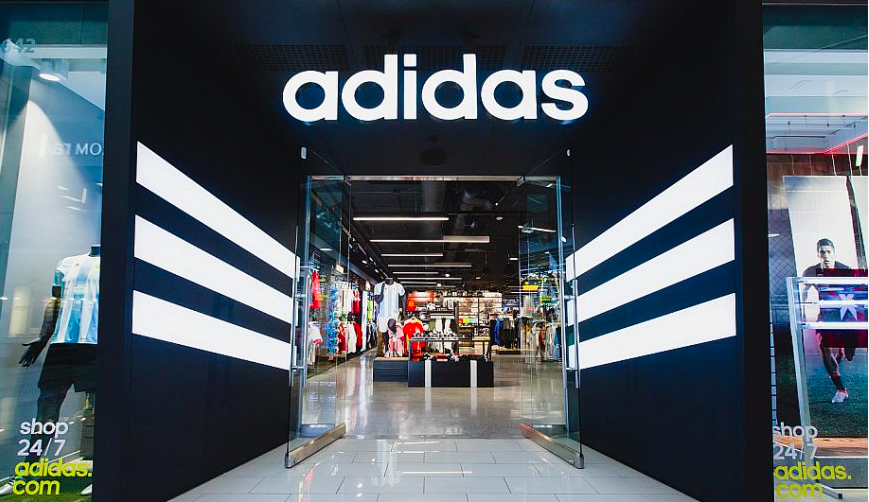Adidas said it expects supply-chain bottlenecks in North America to slow its growth to between 3 percent and 4 percent in the first half of 2019 before accelerating in the second half. The company still expects growth between 5 percent and 8 percent on a currency-neutral basis overall in 2019, including high-single-digit growth in North America.
While wrapping up another strong year of growth in 2018, Adidas said in providing its 2019 outlook, “While the company is experiencing a strong increase in demand for mid-priced apparel, Adidas will not be able to immediately cover this demand in full due to supply chain shortages. Consequently, growth is expected to be negatively impacted, particularly in North America during the first half of the year.”
Major Developments In 2018:
- Currency-neutral revenues up 8 percent
- Double-digit growth in strategic growth areas Adidas North America, Greater China, e-commerce
- Operating margin increases 1.1pp to 10.8 percent
- Net income from continuing operations grows 20 percent to €1.709 billion
- Reebok returns to profitability
- Management proposes dividend increase of 29 percent to €3.35 per share
Outlook For 2019:
- Currency-neutral sales to increase between 5 percent and 8 percent
- Operating margin to increase to between 11.3 percent and 11.5 percent
- Net income from continuing operations to increase between 10 percent and 14 percent
- Record sales, the highest margin in our history, strong net income improvements – 2018 was another successful year for our company.
Kasper Rorsted, Adidas CEO
“We have made great strides toward and are confirming our 2020 financial ambition. Our strategic growth drivers – Adidas North America, China and e-commerce – once again delivered double-digit growth. In 2019, we will continue to drive the execution of ‘Creating the New’ to deliver another year of quality top-line growth and over-proportionate bottom-line improvements,” said Adidas CEO Kasper Rorsted.
Financial Performance In 2018
Currency-neutral sales increase 8 percent in 2018
In 2018, Adidas delivered another year of significant top-line growth with currency-neutral revenues increasing by 8 percent. This development was driven by a 9 percent improvement at brand Adidas, reflecting a double-digit sales increase in Sport Inspired as well as a high-single-digit gain in Sport Performance. The latter was driven by double-digit sales growth in the training and running categories. Currency-neutral Reebok brand sales were down 3 percent versus the prior year, as double-digit sales growth in Classics was offset by a decline in Sport. From a channel perspective, the company’s top line increase was largely driven by double-digit improvements in direct-to-consumer revenues with particularly strong support from e-commerce, where revenues grew 36 percent to more than €2 billion in 2018. In euro terms, the company’s revenues grew 3 percent to €21.915 billion (2017: €21.218 billion), reflecting significant negative currency translation effects.
Double-digit growth in North America and Asia-Pacific
From a market segment perspective, the top-line expansion in 2018 was driven by ongoing strength in the company’s strategic growth regions: The combined sales of the Adidas and Reebok brands continued to expand at strong double-digit rates in both North America (+15 percent) and Asia-Pacific (+15 percent), the latter driven by a 23 percent increase in Greater China. Currency-neutral revenues in Latin America were up 6 percent and sales in Russia/CIS increased 1 percent as the positive impact from World Cup-related sales offset the significant amount of store closures. While sales in Europe remained flat compared to the prior year level, revenues in Emerging Markets declined 3 percent.
Operating margin increases 1.1 percentage points to 10.8 percent
The company’s gross margin increased 1.4 percentage points to 51.8 percent (2017: 50.4 percent). This development was due to the positive effects from a better pricing, channel and product mix as well as lower input costs, which more than offset significant negative currency effects. Other operating expenses were up 5 percent to €9.172 billion in 2018 (2017: €8.766 billion).1 As a percentage of sales, other operating expenses increased 0.5 percentage points to 41.9 percent from 41.3 percent in 2017. This increase was mainly driven by higher marketing investments. In 2018, marketing and point-of-sale expenses amounted to €3.001 billion reflecting growth of 10 percent compared to the prior year level (2017: €2.724 billion). This development was largely due to activities related to the 2018 FIFA World Cup as well as overproportionate investments into the company’s brands and the sell-through of its products. As a percentage of sales, marketing and point-of-sale expenses grew 0.9 percentage points to 13.7 percent (2017: 12.8 percent). Operating overhead expenses increased 2 percent to €6.171 billion (2017: €6.042 billion), due to further investments into the company’s scalability. As a percentage of sales, operating overhead expenses decreased 0.3 percentage points to 28.2 percent (2017: 28.5 percent). The company’s operating profit grew 14 percent in 2018 to €2.368 billion (2017: €2.070 billion), representing an operating margin increase of 1.1 percentage points to 10.8 percent (2017: 9.8 percent). This development was mainly due to the gross margin increase, which more than offset the investment-led increase in other operating expenses. The operating margin increase was also supported by strong profitability improvements at the Reebok brand, which returned to profitability in 2018. This reflects a profit uplift of more than €150 million for the brand since the launch of its turnaround plan ‘Muscle-Up’ at the end of 2016.
Net income from continuing operations up 20 percent
Excluding the negative one-time tax impact recorded in 2017, the company’s tax rate declined 1.2 percentage points in 2018 to a level of 28.1 percent (2017: 29.3 percent). Net income from continuing operations increased 20 percent to €1.709 billion (2017: €1.430 billion). Basic EPS from continuing operations grew 20 percent to €8.46 from €7.05 in 2017. Losses from discontinued operations, mainly related to the divestiture of the Rockport business, amounted to €5 million (2017: €254 million). As a result, net income attributable to shareholders, which in addition to net income from continuing operations includes the losses from discontinued operations, grew 45 percent to €1.702 billion (2017: €1.173 billion), resulting in basic EPS from continuing and discontinued operations of €8.44, up 46 percent compared to €5.79 in 2017.
Average operating working capital as a percentage of sales decreases
At the end of December 2018, inventories decreased 7 percent to €3.445 billion (2017: €3.692 billion). On a currency-neutral basis, inventories decreased 5 percent, reflecting the company’s focus on tight inventory management. Accounts receivable increased 4 percent to €2.418 billion at the end of December 2018 (2017: €2.315). Average operating working capital as a percentage of sales from continuing operations decreased 1.4 percentage points to 19.0 percent (2017: 20.4 percent), reflecting the strong top-line development during the last twelve months as well as the company’s continued focus on tight working capital management.
Net cash position of €959 million
Net cash at December 31, 2018 amounted to €959 million, compared to net cash of €484 million in 2017, representing an improvement of €475 million compared to the prior year. This development was driven by the increase in cash generated from operating activities, partly offset by the utilization of cash for the purchase of fixed assets as well as the repurchase of Adidas AG shares and the dividend paid to shareholders. In addition, the conversion of convertible bonds into Adidas AG shares also contributed to this improvement.
Strong focus on driving shareholder return
As a result of the strong operational and financial performance in 2018, the company’s strong financial position as well as Management’s confidence in Adidas’ short- and long-term growth aspirations, the Executive and Supervisory Boards will recommend paying a dividend of €3.35 per dividend-entitled share to shareholders at the Annual General Meeting on May 9, 2019. This represents an increase of 29 percent compared to the prior year dividend (2017: €2.60) and a payout ratio of 39.0 percent (2017: 37.0 percent) of net income from continuing operations. This is within the target range of between 30 percent and 50 percent of net income from continuing operations as defined in the company’s dividend policy. In addition, Adidas continues its multi-year share buyback program launched in March 2018. In total, under the current program, Adidas plans to buy back own shares for up to €3.0 billion between March 2018 and May 2021. After the completion of the first tranche, during which Adidas bought back own shares for a total consideration of €1 billion in 2018, the company intends to repurchase own shares worth around €800 million in 2019.
Financial Performance In Q4 2018
Currency-neutral sales increase 5 percent in the fourth quarter of 2018
During the fourth quarter, Adidas revenues increased 5 percent on a currency-neutral basis, on top of 19 percent growth in the prior year period. This development reflects an increase of 5 percent at brand Adidas. Double-digit growth in Sport Inspired and in the training category as well as high-single digit growth in running were partly offset by a strong decline in football revenues reflecting the non-recurrence of sales related to the 2018 FIFA World Cup in the prior year’s quarter. Revenues at the Reebok brand declined 1 percent, as the double-digit increase in Classics was more than offset by a decline in Sport. In euro terms, sales for the company were up 4 percent to €5.234 billion in 2018 (2017: €5.056 billion).
Double-digit growth in Asia-Pacific
On a currency-neutral basis, the combined sales of the Adidas and Reebok brands continued to grow at double-digit rates in Asia-Pacific (+11 percent), driven by a 13 percent increase in Greater China. Sales in North America grew 9 percent, on top of a 31 percent increase in the prior year period, driven by continued double-digit growth for the Adidas brand. Currency-neutral revenues in Latin America (-1 percent) and Russia/CIS (-2 percent) declined at a low-single-digit rate, while sales in Emerging Markets (-5 percent) and Europe (-6 percent) decreased at a mid-single-digit rate.
Gross margin up 0.5 percentage points to 52.2 percent
The company’s gross margin increased 0.5 percentage points to 52.2 percent (2017: 51.7 percent), mainly due to the positive impacts from a better product and channel mix as well as lower input costs, which more than offset significant negative currency effects. Other operating expenses were up 5 percent to €2.645 billion (2017: €2.517 billion). This development reflects a significant increase in marketing expenditure as well as higher operating overhead expenditure. As a percentage of sales, other operating expenses increased 0.7 percentage points to 50.5 percent (2017: 49.8 percent). The company’s operating profit decreased slightly to €129 million from €132 million in 2017, representing an operating margin of 2.5 percent (2017: 2.6 percent). Excluding the negative one-time tax impact recorded in the fourth quarter 2017, net income from continuing operations increased 29 percent to €93 million (2017: €72 million). Basic EPS from continuing operations was up 33 percent to €0.47 from €0.35 in 2017. Gains from discontinued operations amounted to €15 million compared to losses of €38 million in the prior year period. As a result, net income attributable to shareholders, excluding the negative one-time tax impact, grew to €108 million (2017: €34 million), resulting in basic EPS from continuing and discontinued operations of €0.54, compared to €0.17 per share in 2017.
Outlook For 2019
Adidas expects top-line growth of between 5 percent and 8 percent in 2019
The company projects sales to increase at a rate of between 5 percent and 8 percent on a currency-neutral basis in 2019. While the company is experiencing a strong increase in demand for mid-priced apparel, Adidas will not be able to immediately cover this demand in full due to supply chain shortages. Consequently, growth is expected to be negatively impacted, particularly in North America during the first half of the year. The overall impact on the company’s full year growth rate in 2019 is anticipated to be between 1 and 2 percentage points. Adidas anticipates growth of between 3 percent and 4 percent in the first half of 2019, followed by a sequential acceleration during the second half of the year as the company will be able to scale the respective supply over time.
Currency-neutral revenues to increase in all market segments
While currency-neutral revenues in Asia-Pacific are projected to grow at a double-digit rate, currency-neutral revenues in North America and Emerging Markets are expected to grow at high-single-digit rates. Sales in Latin America and Russia/CIS are forecast to improve at a low-single-digit rate in currency-neutral terms. In Europe, the company expects to return to growth in the course of the year and forecasts a slight increase in currency-neutral revenues for the full year.
Bottom line to grow at double-digit rate
The company’s gross margin is forecast to increase to a level of around 52.0 percent (2018: 51.8 percent). The operating margin is expected to increase between 0.5 percentage points and 0.7 percentage points to a level between 11.3 percent and 11.5 percent (2018: 10.8 percent). This, together with continued top-line growth, is expected to once again drive a double-digit-rate improvement of the company’s bottom line: Net income from continuing operations is projected to increase to a level between €1.880 billion and €1.950 billion, reflecting an increase of between 10 percent and 14 percent compared to the prior year level of €1.709 billion.
Image courtesy Adidas
















